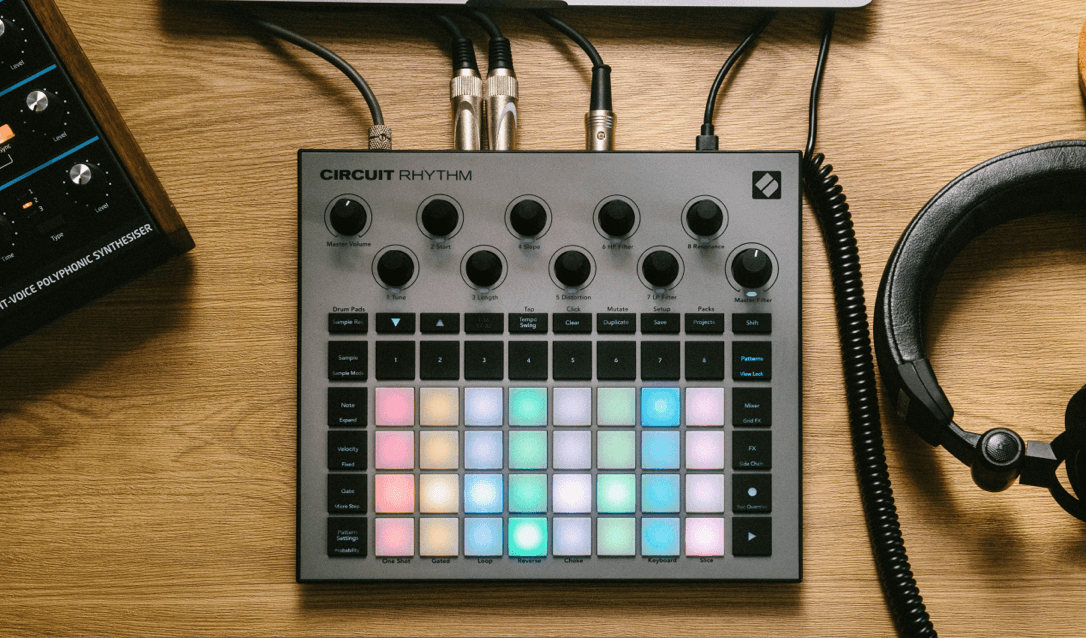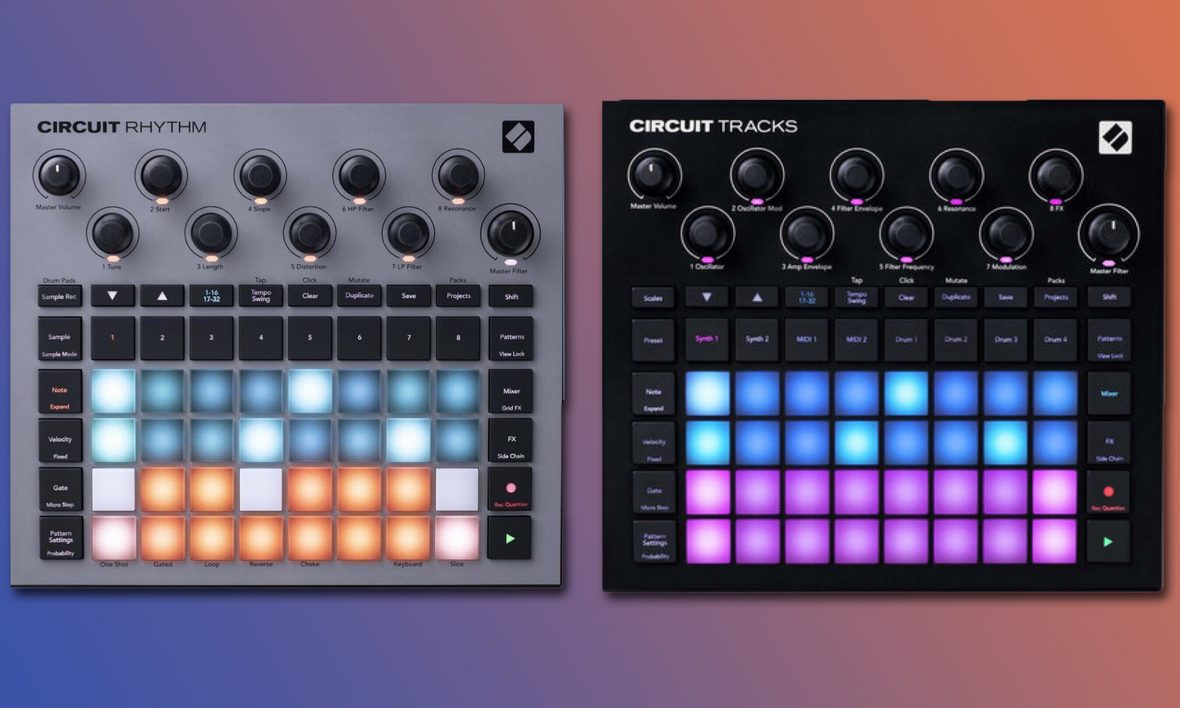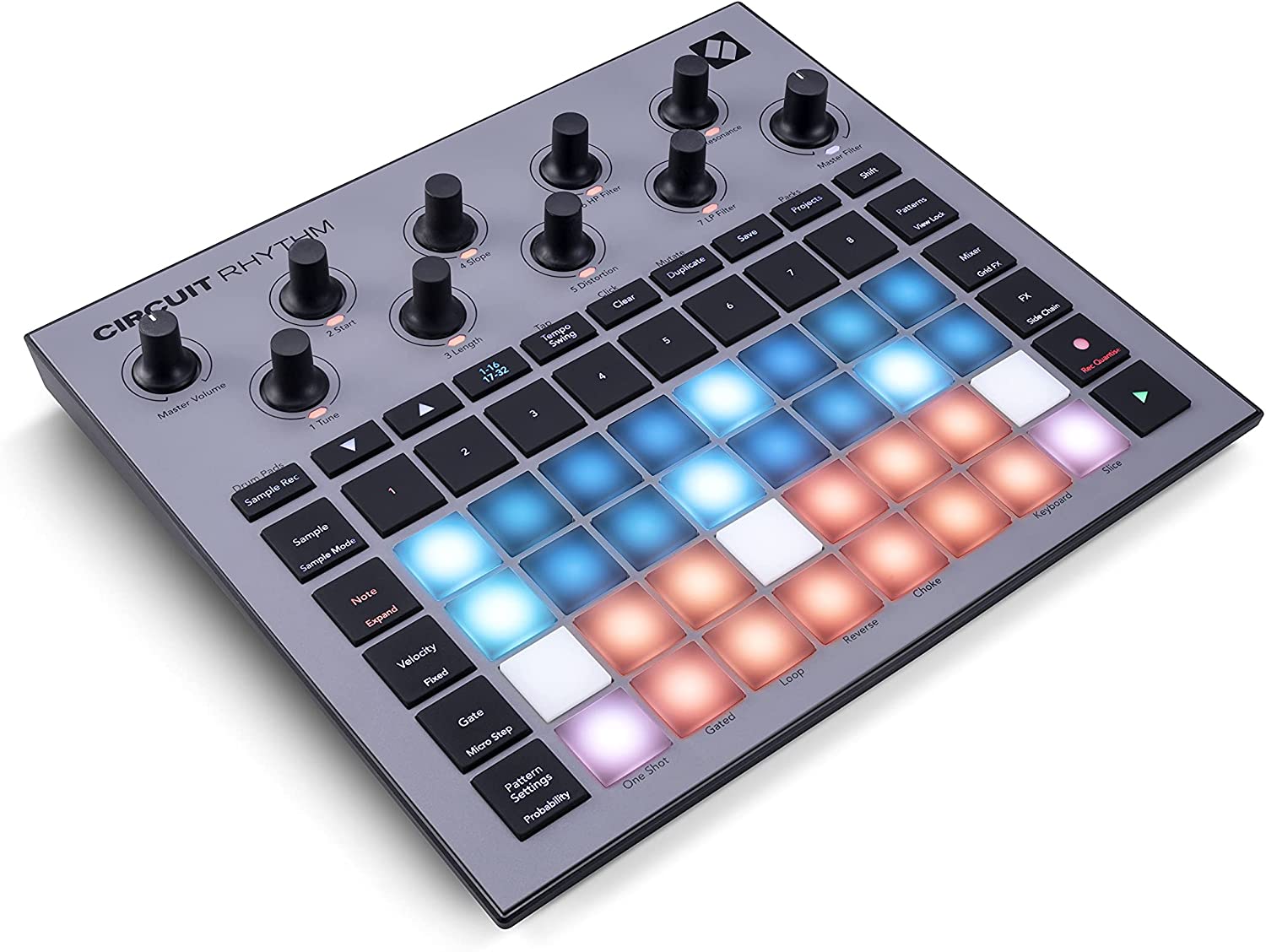Sampler for everywhere: Novation Circuit Rhythm

About half a year ago, we had the small Circuit Tracks groovebox in for review. Now, the Circuit Rhythm is also available and came to our studio for several weeks of testing.
Differences from the tracks
Externally, the only difference between the two devices is the color: Instead of black, the Rhythm comes in concrete gray. Internally, the division is such that the Tracks focuses on synthesizer sounds, while the Rhythm is responsible for the beats. Therefore, the Rhythm lacks the two polyphonic synthesizer tracks, as well as the two additional MIDI tracks for controlling external sound generators. Instead, the drum tracks have been doubled; instead of four, Rhythm offers eight of these sample-based tracks. The crucial difference is that Circuit Rhythm can record samples directly on the device via the audio inputs, while Tracks relies on import only via computer and USB. The maximum available sampling time has also been increased by a good 24 seconds to a total of 220 seconds.
... and similarities
Otherwise, the Rhythm, like the Tracks, has an internal battery, as well as DIN MIDI connections, two audio inputs and an analog sync output. Presets, samples and projects can be stored and exchanged on MicroSD; sequencer and effects have been sensibly expanded compared to the first generation of Circuit. With 32 multi-colored, velocity-sensitive pads, rhythms or monophonic sequences can either be recorded in real-time or programmed. There are also eight endless rotary controls for adjusting sound parameters and effects for the selected track. There are also two pots for the global parameters Volume and Master Filter (high and low pass filter types combined, with center grid), plus a total of 28 backlit buttons.

Circuit philosophy
Novation‘s Circuit series is supposed to be able to produce electronic music in a few minutes, and Circuit Rhythm also shares this concept. There is no display - the most important Synth and Sequencer �Parameters are available directly from the front panel and are operated by ear. For more in-depth editing and sound exchange, the free Components software is available as a standalone installation or browser software.
Compact and solid
The slightly beveled case is made of solid plastic, with angled sides and curves for a comfortable grip. Dimensions and weight are the same as Tracks. At 240 x 200 x 30 mm and only 760 grams, Rhythm is extremely portable. The robust pots are firmly mounted to the housing, making them suitable for rougher use on stage or on the road; and the rubberized caps feel good to the touch. The multicolored, illuminated pads offer the familiar and proven good feel, but they are too small for excessive finger drumming.
Three MIDI jacks (IN/OUT/THRU) in classic DIN format save fiddling with adapters like other compact and inexpensive devices. On top of that, audio outputs are also present as a pair of full-size 6.3mm jacks.
Slightly weakly lit
A multicolored LED below the endless knobs shows the currently set value of the parameter by means of brightness. This works quite well in practice, but in some cases we would have liked a clearer display for the average or zero value. The buttons are also illuminated, but the color only shines through the text of the otherwise black buttons. This looks nice, but in difficult lighting conditions on stage or in sunlight, the status is more difficult to recognize.
Sampler rather than sample player!
As with Tracks, there are two audio inputs. In contrast to Tracks, however, you can not only loop in external sound generators, but also record them and use them as samples or loops on the tracks. Recording starts directly at the touch of a button or automatically when a configurable volume threshold is reached. Appropriately, there is an analog clock output to synchronize drum machines and other sound generators to the Circuit‘s sequencer. A single sample can be a maximum of 32 seconds long, and the pads roughly indicate the time used and what’s still available when recording.
As an alternative to direct recording, you can get your own samples into the groovebox using the Components software and the SD card.

Post-processing
Samples can be post-processed in a rudimentary way. You can adjust the starting point and the length, but this has to be done by ear due to the lack of a display. This works quite well in practice, since you can switch between coarse and fine value settings using the shift key. Other customizable and also automatable parameters are a 1-button envelope for the volume curve, distortion effect, a high-pass filter (to remove the bass drum from a loop, for example) and a low-pass filter with resonance.
Slicing
Samples can also be sliced, that is, broken down into individual parts. This can be done rhythmically using an adjustable divider ( for example 1/8 or 1/4) which, of course, only works well with material in the correct project tempo. Alternatively, you can set the slices live while playing the sample. We‘d also like to see splitting by transients, as well as time-stretching to match loops at a different tempo.
Mono samples only
The biggest drawback with the sampling function, which is very welcome in itself, is that Rhythm can only process mono samples internally despite two audio inputs. Left and right channels are mixed together when a stereo source is connected. This is something that much more expensive devices like the Elektron Digitakt or Analog Rytm can‘t do any better, and it can be argued that mono samples are usually sufficient for drums. But for a groovebox with only limited individual effects per track, it would also be nice to be able to record a snare directly with wide stereo reverb, for example, or play back a stereo loop.
Rechargeable instead of batteries
Circuit Rhythm has a built-in battery with a runtime of a good 4 hours. The advantage of this solution is the direct integration and charging possibility; the disadvantage is that it‘s more difficult to replace in case of a defect or decreasing performance.
When connected to the computer through the USB-C port, the computer takes over the power supply, or you can use an external power supply. If you accidentally pull the plug or power fails on stage, Circuit Tracks switches to battery power without loss. This built-in emergency power supply provides additional safety during live use.
Send and master effects
The Delay and Reverb effects, as well as the filters, are familiar from other Circuit products: They are sufficient for the intended purpose, but for the final studio production, you will probably resort to other effects in the end.
The master compressor is useful for creating fat beats; making Circuit sound a bit punchier and more dynamic. At least as important for a modern sound is the new sidechain option for making basses and pads pump and creating space for the kick. Unfortunately, unlike Tracks, this does not work with external audio signals, nor are Reverb and Delay available for this purpose. We also missed the built-in speakers of the early Circuit models a bit.
Performance effects
Rhythm also features performance effects such as Beat Repeat, Gater, Vinyl, Filter and Reverse. Up to 16 of these tempo-synchronized grid effects can be arranged according to your own ideas and launched directly via the pads during live performance to loosen up the pattern and create a fill or prepare a drop. By the way, these performance effects also work with external audio signals that are looped into the Rhythm.
32-Step Sequencer
The sequencer is basically the same as in the other Circuit models. A pattern consists of up to 32 steps and can be loosened up with various functions so that it doesn‘t seem too static and boring even when there are only 16 or 32 steps. With the probability option, inspired by Elektron machines, you set a percentage probability for each step that it will be played during a run of the sequence. At 100%, the step will always trigger, at 50% there is a 1:1 chance. Different playback directions, like ping-pong and random, also serve to loosen things up; and with the MicroSteps, you can bring more groove into strictly quantized beats or create ratchets and other rhythmic gimmicks.
With the Mutate function, you can deliberately mix up the entire pattern; however, the basic pitches are retained, so that no disharmonic random results occur.
Sample flip
Thanks to sample flip, you can use several different samples on one track and, for example, combine open and closed hi-hat or kick and snare on one track. This allows for much more complex beats than you would expect with eight tracks. Theoretically, you can choose a different sample for each step. The only difference is that the samples on a track cannot be triggered at the same time, since the tracks are strictly monophonic. Samples can also be played chromatically to create monophonic bass lines and melodies. The pads can be used to play notes in like a keyboard with 1 or 2 octaves. For polyphonic sounds, the appropriate chords would have to be sampled directly or several tracks would have to be combined, which then requires some brain power.
Pattern combination
Each of the eight tracks offers up to 8 patterns, which can be intuitively combined in the View Lock in a similar way to Ableton‘s Session View with Push using the pads - including pattern chaining! Up to eight patterns can be chained together in Rhythm, allowing for chains of up to 256 steps. You can then save the selected pattern combination as a Scene. In mixer mode, you can switch between different Scenes using the two lower rows of pads and, therefore, prepare the flow of complete songs.
Want more? Get more!



Subscribe to the digital edition of BEAT Magazine via Plugins-Samples.com and get more gear, in-depth workshops, reviews and 11 GB exclusive plugins and new sounds with every monthly issue!
Subscribe to Beat Magazine for only 4.99€ per month
